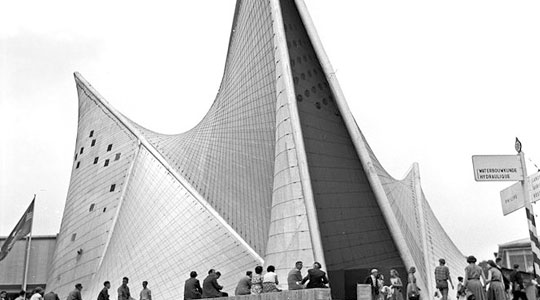The History of Electronic Music in the Netherlands

Kees Tazelaar, director of the Institute of Sonology in The Hague, will reconstruct the birth and evolution of electronic music in the Netherlands, which revolved around notable institutions such as the Philips Studios (which supported a laboratory of experimentation in sound and new technologies, assembling leading thinkers and researchers such as Iannis Xenakis, Le Corbusier, and Edgard Varèse during the postwar period), the Art Science Interfaculty, and the Institute of Sonology. The latter two remain bustling creative laboratories for forward-thinking artists and projects today.
A teacher at the Institute of Sonology in Utrecht (1981-83) and the Hague (1987-1989), student of Jan Boerman and Graduate of the Royal Conservatory in The Hague in 1993, and head of the Institute of Sonology in The Hague since 2006, Kees Tazelaar also creates his own compositions, has worked to restore and reconstruct major electronic works from past luminaries such as Iannis Xenakis, Györgi Ligeti, Edgard Varèse, and Gottfried Michael Koenig, to name a few. and has contributed to music theatre projects by the late Dick Raaijmakers. His new publication, On The Threshold of Beauty: Philips and the Origins of Electronic Music in the Netherlands, 1925–1965, explores the development of electronic music at the Philips research laboratory, the collaboration between Xenakis, Le Corbusier, and Varèse on the now legendary Philips Pavilion (Word Expo 1958), and the first electronic music studios in the Netherlands.
Conceived by Tazelaar, the four-part programme on electronic music pioneers in the Netherlands provides a rare opportunity to learn about the region’s vibrant and interconnected developments throughout the 1950s-1980s and into the present day. Tazelaar’s personal connection to many of the protagonists themselves, and his intimate familiarity with their works and research, will be highlighted through an introductory lecture at the outset of the programme.
Following the lecture, Tazelaar presents multichannel diffusions of a wide selection of pioneering works curated especially by himself for the evening, providing a unique chance to experience works by an extensive cast of sound researchers and composers. Presented in three parts, each of the sound diffusion concerts also includes live performances.
In the Concert 1 programme, violinist and experimental musician Ekkehard Windrich performs a solo piece by Henk Badings, known for us his of unusual musical scales such as the octatonic scale, as well as the harmonic series from the eight to fifteenth overtone. Windrich is joined by pianist Frank Gutschmidt (regular performer with the Kammerensemble Neue Musik Berlin) in the Concert 2 programme, to perform a work by Gottfried Michael Koenig, a musician and composer who taught and was director and chairman of the electronic music studio at the University of Utrecht, which later became the Institute of Sonology. CTM is honoured to host the now 87 year-old Koenig, who has made a special trip to Berlin to be present for the work's presentation.
The third and final Concert 3 programme features a live sextet performance of Ton de Leeuw’s "Antiphonie for wind quintet and tape" (1960), a composition that is played in public for the first time since the year of its composition, as well as Luc Döbereiner’s "K2 for piano and computer", performed by the composer himself (on computer), with Frank Gutschmidt on piano.
Detailed Programme Schedule
Lecture
15:00–16:00
- Kees Tazelaar – "Electronic Music Pioneers in the Netherlands"
Concert I
16:30–17:30
- Jan Boerman (*1923) – "Alliage", 13', tape (1959, studio TH Delft)
- Ton de Leeuw (1926–1996) – "Elektronische Studie", 7', tape (1957, studio NRU Hilversum)
- Henk Badings (1907–1987) – "Capriccio for violin and tape", 8' (1959, studio Philips Research Laboratories Eindhoven). Ekkehard Windrich: Violin
- Dick Raaijmakers (1930–2013) – "Fuel for the Future", 12', tape (1960, studio Philips Research Laboratories Eindhoven)
- Jaap Spek (1929–2001) – "Impulsen", 8', tape (1960, studio TH Delft)
- Tom Dissevelt (1921–1989) – "Gamelan", 5', tape (1963, STEM studio Utrecht University)
- Edgard Varèse (1883–1965) / Le Corbusier (1887–1965) – "Le poème électronique", 8', tape and video (1958, studio Philips ELA Eindhoven)
Concert II
19:00–20:00
- Ton Bruynèl (1934–1998) – "Réflexes", 5', tape (1961, studio Bruynèl / STEM studio Utrecht University)
- Will Eisma (*1929) – "BTH3457", 5', tape (1963, CEM studio Bilthoven)
- Gottfried Michael Koenig (*1926) – "Segmente 99–105 for violin and piano", 15' (1982, Institute of Sonology Utrecht). Ekkehard Windrich: violin. Frank Gutschmidt: piano
- Kees Tazelaar (*1962) – "Projection", 13', tape (2009, Institute of Sonology Den Haag)
- Dick Raaijmakers (1930–2013) – "Canon 1", 5', tape (1964, studio Boerman/Raaijmakers Den Haag)
- Jan Boerman (*1923) – "De zee", 18', tape (1965, studio Boerman/Raaijmakers Den Haag)
Concert III
20:30–21:30
- Tom Dissevelt (1921–1989) – "Ignition", 4', tape (1963, STEM studio Utrecht University)
- Ton de Leeuw (1926–1996) – "Antiphonie for wind quintet and tape", 15' (1960, studio Philips Research Laboratories Eindhoven). Aaron Dan: flutes. Simon Strasser: oboe. Winfried Rager: clarinets. Alexander Hase: bassoon. Samuel Stoll: horn. Ekkehard Windrich: tape
- Ton Bruynèl (1934–1998) – "Résonance 1", 14', tape (1962, studio Bruynèl Utrecht)
- Luc Döbereiner (*1984) – "K2 for piano and computer", 9' (2009, Institute of Sonology the Hague). Frank Gutschmidt: piano. Luc Döbereiner: computer
- Gottfried Michael Koenig (*1926) – "Terminus II", 20', tape (1967, STEM studio Utrecht University)
Presented with the kind support of the société Gavigniès and the Mondriaan Fund.


